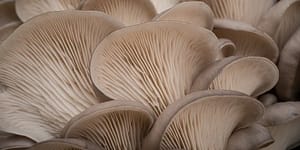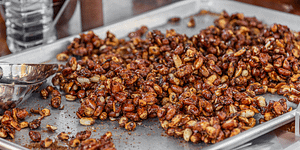Wild Spicy Forest Paste

In his new book Wildcrafted Fermentation, professional forager Pascal Baudar combines his curiosity, research, and in-depth understanding of terroir to explore new and surprising uses for wild ingredients through fermentation.
The following is an excerpt from the Chelsea Green Spring 2020 Seasonal Journal. It has been adapted for the web
Springtime offers an abundance of delicious and tender wild greens such as chickweed, miner’s lettuce, wild chervil, tender young grass (foxtail), watercress, bitter cress, and countless others. Eating a freshly foraged salad is truly an epiphany of green flavors in your mouth: earthy, a punch of chlorophyll, grassy, the perfect balance of sweet and bitter. You cannot even approach those flavors with ingredients purchased at the store. And they can be preserved for use year-round in the form of pastes.
Spicy Forest Paste
I usually serve this paste on top of my acorn and wild seeds crackers, but it will work nicely on eggs, grilled steaks, and even fish. If your diet is plant-based, I would spread the paste on vegan pizza or simply use it as a savory side condiment.
Ingredients
Makes a ½-pint jar (236 ml)

Image from Wildcrafted Fermentation
- 2 large jalapeño peppers, seeds removed, cut into large pieces
- 2 ½ cups (75 g) minced forest herbs (I use 60 percent chickweed, 20 percent chervil, 10 percent miner’s lettuce,10 percent others)
- 1 cup (30 g) lemon basil
- 1 cup (30 g) cilantro
- 7 garlic cloves, peeled
- 2 tablespoons (30 ml) Culture Starter
- 4½ tablespoons (27 g) paprika
- 2 tablespoons (15 g) Korean chili flakes
- ¾ teaspoon (2 g) ground coriander
- 1 teaspoon (2.5 g) chile morita or spicy chili flakes
- ¾ teaspoon (1 g) ground cumin
- 2 teaspoons (4 g) ginger powder or 1 tablespoon (5 g) grated fresh ginger root
- 1 teaspoon (3 g) garlic powder
- ½ teaspoon (1.5 g) ground black peppercorns
- 1 teaspoon (2 g) turmeric
- Salt
Procedure
- Process the jalapeños, forest herbs, lemon basil, cilantro, garlic, and starter in a blender until you get a smooth paste.
- Place this in a bowl, and add the spices, stirring to combine.
- Mix the salt with the paste and transfer to a jar.
- Close the lid and stir the ferment a couple of times daily until the fermentation gases subside, usually 7 to 10 days. You’ll need to burp as necessary.
Recommended Reads
Recent Articles
What’s so great about oyster mushrooms? First, you can add them to the list of foods that can be grown indoors! They are tasty, easy to grow, multiply fast, and they love a variety of substrates, making oyster mushrooms the premium choice. The following is an excerpt from Fresh Food from Small Spaces by R. J.…
Read MoreCraving something sweet? These delicious maple roasted nuts are the perfect treat to help you push through those end-of-winter blues. The following is an excerpt from Full Moon Feast by Jessica Prentice. It has been adapted for the web. The Magic of Maple: A Rich History Following the Hunger Moon, just before the first thaw…
Read MoreDoes the cold weather have you dreaming about fresh greens and colorful salad? Grow and harvest sprouts indoors to make those dreams a reality! Follow this quick start guide to year-round greens for fresh salad greens in just a couple of weeks! The following is an excerpt from Year-Round Indoor Salad Gardening by Peter Burke. It…
Read MoreMove aside, maple! We have two new syrups to add to the table. Read on for insights on tapping, selling, and eating syrup from walnut & birch trees.
Read More








